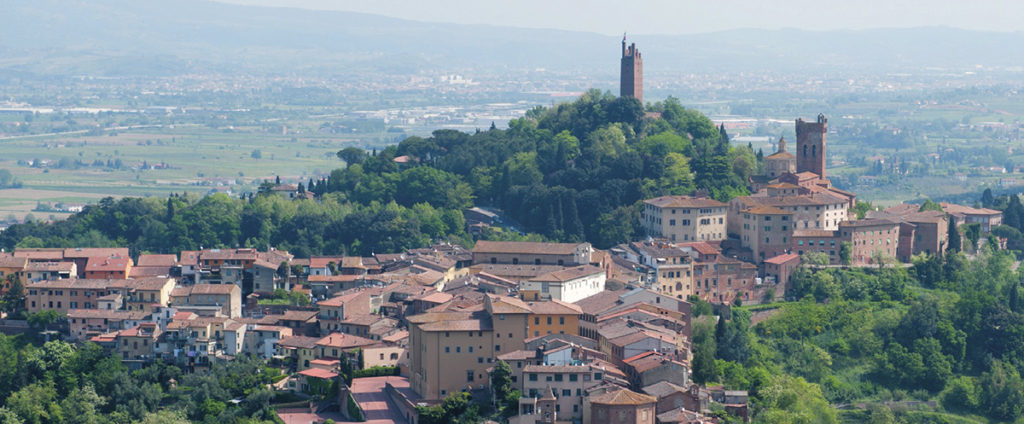
Cold weather brings truffles, which are found in Tuscany in the hills of San Miniato, overlooking the Arno river valley on the way to Pisa. The quality and quantity of the local white truffles (Tuber magnatum) make the name of the town synonymous with the coveted treat. Truffle dishes can be enjoyed throughout the winter close to the source in San Miniato, which makes an enjoyable day trip from Florence.
San Miniato may be an unfamiliar name to some—except to those who have seen the film La Notte di San Lorenzo. The Night of Shooting Stars, as it is called in English, recounts the story of the town’s shelling during the Second World War. To others it may be known only for its celebrated, award-winning truffles.
Just around the corner from the Church of the Crucifix and town hall is the venue of the annual truffle market, which fills the air with delectable aromas. Below the San Miniato hills are truffles, in addition to the remains of a medieval city and perhaps even the saint for which it is named.
Unlike history, white truffles are entirely hidden from sight. For this reason, special dogs are employed by tartufai (truffle hunters) to use their noses to find the treasures that lie beneath their feet. The forested hills around San Miniato produce 25% of Italy’s white truffle—a portion of which is available to purchase and enjoy every November at the Truffle Fair, and the rest of the time in truffle specialties offered by local restaurants.
San Miniato Alto (Upper San Miniato) has a documented past that stretches back to the Middle Ages. The hilltop town was at one point the resting place of the saint known as San Miniato, who has the honor of being Florence’s one and only Christian martyr.
The connection to Germany goes deep into the history of San Miniato, which in the 13th century was the official residence of the envoys of the Holy Roman Empire. For this reason the town was originally called “San Miniato al Tedesco” (“German San Miniato”). Germanic ruler Frederick Barbarossa briefly stayed here, as did Henry VI and Otto IV. Frederick II (1194-1250), the Teutonic head of the Holy Roman Empire, lived in San Miniato long enough to reinforce the town’s defenses.
Another notable historical figure who visited the town, although not German, is Napoleon Bonaparte. Originally from San Miniato, the Bonaparte family eventually moved to Corsica, and young Napoleon returned in 1796 with his father in search of documents proving his nobility.
Much of San Miniato, including a tower that Emperor Frederick built, was leveled during the Second World War. The movie Night of the Shooting Stars was based on a tragedy that occurred on July 22, 1944 when a stray Allied shell came through a window of the cathedral (Duomo). The explosive ricocheted off a stone relief and detonated against a column to the right of the altar, killing 55 civilians who had taken refuge in the church. Later restored, this quiet, red brick sanctuary in the Romanesque style shows no lingering signs of devastation.
Built in the 13th century, the present Duomo is located on the site of an earlier church dedicated to the Annunciation. The relief that was caught in the crossfire, a sacred artwork from the 13th century depicting the Annunciation, was merely chipped by the shell in its trajectory and can be viewed in the adjacent Cathedral museum. The town’s famous tower, commissioned by Frederick II, did not enjoy the same good fortune, and was destroyed by the Germans. Long a symbol of San Miniato, it was rebuilt exactly where it formerly stood.
An historic tower, which was spared the fate of Frederick’s tower, still stands and is now attached to the Duomo. Piercing the sky and making its own noticeable mark on San Miniato’s skyline, Matilda’s tower watches over the former fortress town. An ancient clock serves as a reminder of its authenticity. The majesty of the tower is a testament to the power of medieval San Miniato.
Below the tower and across the street is another, perhaps clearer, testament to the town’s rich history: the Palazzo Comunale, the city hall. Inside, the walls are adorned with art from the Middle Ages, including a representation of the Madonna surrounded by saints and famous names of San Miniato. The room next to this, the City Council Chamber, holds representations of the towns surrounding San Miniato and are a visual reminder of the many conquests of neighboring villages. Florentine family crests record the untimely end of the town’s golden age: in 1360, Florence conquered the city, drawing the curtains on the era of Sanminiatese influence.
Across the street from the Palazzo Comunale is the Chiesa del Santissimo Crocifisso (Church of the Holy Crucifix) that stands over elegant stone steps that stretch down from the church to the street below. Inside, the church is decorated with beautiful, baroque artwork that gives the space a calm elegance. (raymond schmelzer)
Related article on beautifulflorence.blogspot.it








